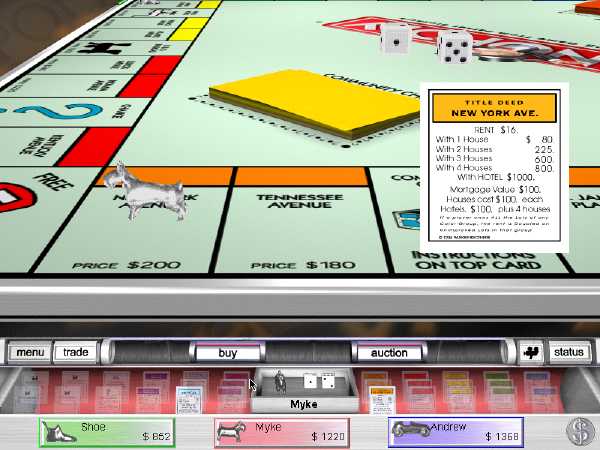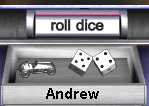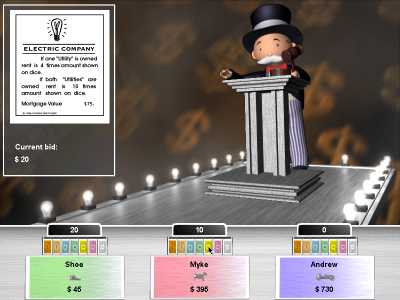
History of the Game
The traditional Monopoly game was created in 1934 (during the Great Depression)
and was originally rejected by Parker Brothers because of what they called
"52 design errors." The creator of the game, Charles Darrow, found a friend
to print the board for him and the pieces were hand-carved. Soon, they couldn't
keep up with demand and was finally able to convince Parker Brothers to produce
the game.

Review of how to play
Everyone knows how to play Monopoly -- two to eight players move a token around
a square board, buying properties and collecting rent when other people land on
them. Two dies are used for each turn and you can get an additional turn for
 rolling doubles. In the computer version, the current player is indicated in a
small grey box (see picture) and the computer plays a sound, appropriate for
that token (such as "Roll Them Bones, Doggie!" or "Racecar, get your motor
revving!"). When the player clicks the "Roll Dice" button, the computer
automatically moves them that number of spaces. One confusing aspect of the game,
in my opinion, is when you get doubles. Instead of announcing that you got doubles
(like the Nintendo version), it simply stays on your turn, but this time without
any audible feedback. When landing on a piece of unowned property, you have the
option to buy or auction it. Auctioning off property that you did not want was also
present in the Nintendo version but is not something that would be easily
implemented in the traditional board game (nor was it). Everything else is done
automatically as well: when you buy a property or land on someone else's, the money
is deducted; when you land on Community Chest or Chance, the card is automatically
displayed with a cool animation. Another place I see potential for improvement is
when you land on a property that you already own. Granted the owner of each
property is indicated with a colored tab on the side of the board and there is a
sound effect such as "I recognize this place, I think" or "Smells like home to me,"
I think that the addition of a status bar which indicated "You already own this
property." would be very helpful. Other helpful status items would include things,
such as "You just paid $14 to Shoe." or "You rolled doubles. Roll again." These
both features that were implemented in the Nintendo version, but not the Macsoft
version. Hasbro/Macsoft's implementation could have been more effective if they
were more limited with the technology, such as Nintendo had been in the early days.
rolling doubles. In the computer version, the current player is indicated in a
small grey box (see picture) and the computer plays a sound, appropriate for
that token (such as "Roll Them Bones, Doggie!" or "Racecar, get your motor
revving!"). When the player clicks the "Roll Dice" button, the computer
automatically moves them that number of spaces. One confusing aspect of the game,
in my opinion, is when you get doubles. Instead of announcing that you got doubles
(like the Nintendo version), it simply stays on your turn, but this time without
any audible feedback. When landing on a piece of unowned property, you have the
option to buy or auction it. Auctioning off property that you did not want was also
present in the Nintendo version but is not something that would be easily
implemented in the traditional board game (nor was it). Everything else is done
automatically as well: when you buy a property or land on someone else's, the money
is deducted; when you land on Community Chest or Chance, the card is automatically
displayed with a cool animation. Another place I see potential for improvement is
when you land on a property that you already own. Granted the owner of each
property is indicated with a colored tab on the side of the board and there is a
sound effect such as "I recognize this place, I think" or "Smells like home to me,"
I think that the addition of a status bar which indicated "You already own this
property." would be very helpful. Other helpful status items would include things,
such as "You just paid $14 to Shoe." or "You rolled doubles. Roll again." These
both features that were implemented in the Nintendo version, but not the Macsoft
version. Hasbro/Macsoft's implementation could have been more effective if they
were more limited with the technology, such as Nintendo had been in the early days.

Versionopoly
Monopoly has become a classic game in that it has been around for generations and
everyone knows about it. It is not, however, a traditional game in Sutton-Smith's
definition, though, since the Monopoly name is a registered copyright (in
addition, trademarks are held on the tokens, the railroads, "Community Chest,"
"Chance," the title deed designs, Boardwalk, and the four corners of the board).
As years have gone by, more and more alternatives to the classic Monopoly game
have popped up. First, it was college-themed like Techopoly, then city-themed like
Atlantaopoly. Today, there are hundreds of different ones, including a new America
edition, a Pokemon edition, a Disney edition, Star Trek edition, Dale Ernhardt
edition, Dogopoly, Millenniumopoly, and so on.
The computer version of Monopoly also has support for different versions, including
Atlantaopoly. The design of the board is the same, but the properties are replaced
with street names or landmarks from the appropriate city. I was disappointed,
though, that these were not fully implemented. While the board does read "Peachtree
Road," the voice says "Kentucky Avenue." In addition, the Chance and Community
Chest cards refer to the classic Monopoly board. Since this is a computer
game, it would have been fairly trivial to have hundreds of options for the alternate
versions (such as Techopoly), but they had less than a dozen.

Classification and conclusion
Monopoly fits into several of Sutton-Smith's taxonomies. It is a race game, including
one token for each player and two die, in the sense that you are racing against other
players for the best properties and the opportunity to pass "Go" again and collect
$200. There is also a strong competition to the game, including revenge. You can
make deals with other players, trade property, and send them back several spaces
(using the Chance cards). In short, Monopoly is a timeless and popular game that
plays apon several skills (deciding wether or not to buy a property, when to
purchase houses/hotels) as well as some chance (rolling the dice).
Sources:
Images captured from Hasbro/Macsoft's Monopoly
Hasbro's Monopoly Website http://www.monopoly.com/
Late for the Sky Productions http://www.lateforthesky.com/
Portions of this paper, including parts of the history and review of how to play, were adapted from an essay I wrote for a previous class, CS 4455: Video Game Design, in the Spring of 2002. While some statements or facts were re-used, this essay was written exclusively for this assignment.